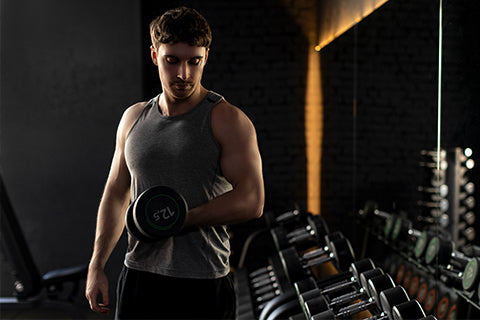June 20, 2025
Madhura Mohan
Beginners Guide To Strength Training
I
f you've ever expressed: "I don't want to get bulky." "I have zero upper body strength." "I wouldn't even know where to start..." you're not alone. The reality is that strength training is not just for bodybuilders or fitness fanatics. Strength training is for you! Regardless of whether you are 18 or 58, a desk jockey or a new mom, strength training is one of the most helpful and transformative assets you can add to your lifestyle.
In this beginner's guide, we’ll discuss how to get started with strength training - from your mindset to your first workout.
What Is Strength Training – Really?
Strength training utilizes resistance such as free weights, bands, or your own body weight to develop muscle strength, muscular endurance, and power. Strength training is much more than merely "pick something heavy up and put it down"! At the core of strength training is the concept of controlling movement, generating force, and being resilient to all the difficulties we face every day!
Why Strength Training Matters More Than You Think?
When we think about strength training, we often assume it's just for bodybuilders or athletes. While that is an option, strength training is one of the best tools for health — especially if you are not currently weightlifting. Here’s why strength training matters more than you realize:
• It protects your body from the inside out - Strength training improves bone density and insulin sensitivity. Stronger muscles, joints, and bones keep lifestyle diseases (like diabetes, osteoporosis, and heart issues) away.
• It rewires your confidence - Lifting weights teaches you more than just how to pick things up. With each session, you learn discipline, focus, and even believe that you can do hard things. That translates into your work, relationships, and mindset.
• It’s the most potent age-defying tool you can use - Muscle loss with age is real but it can be prevented. Building lean muscle early on helps you feel better, move better, feel younger, and stay injury-free.
• It burns calories after your session is done - Unlike cardio workouts, strength training boosts your metabolic rate after the workout is done and even when you rest. In other words, strength training activates your body to use energy more efficiently.
• It readies you for life - beyond the gym – Whether you’re lifting grocery bags, a stroller, or running upstairs, strength training makes everything easier.
How Should Beginners Start Strength Training?
1. START WITH BODYWEIGHT MOVEMENTS
When you first start strength training, your own body is the most convenient, versatile, and smart gym available. Bodyweight movements teach you to control, stabilize, and coordinate—the foundation of every lift. Instead of having your body conquered into a fixed position like you are as you would with a machine, bodyweight exercises make your core, joints, and every supporting muscle work together to achieve lift.
You are not only training a muscle-you are training a movement pattern. Before you touch a weight, learn how to move your own body and control yourself. Getting the basics down will help create stability and prevent injury. You should start with:
• Squats - Develop strength and mobility in the lower body
• Push-ups (knee or wall) - A basic upper body + core strength exercise without injury
• Glute bridges - Getting hips and glutes to activate - vital for posture and back trouble
• Bird Dog – Builds core stability and helps stay in alignment
• Wall sits or chair-assisted lunges - Develops static strength and mental will
2. STICK TO TWO FULL-BODY SESSIONS A WEEK
At the beginning of strength training, your muscles, joints and nervous system are going through adjustments of whole new movement patterns. If you push hard and fast with not enough recovery you may feel burnt out, hit a strength plateau or worse, become injured.
By training with two strength training sessions per week (whole-body each session) you will be able to:
• Train all major muscle groups with a moderate frequency • Provide sufficient recovery of each muscle group for growth and adaptation, • Establish a sustainable behaviour rather than an exhausted grind.
A sample week for a beginner:
Day 1: Full-Body Strength: Focus on compound movements: squats, push-ups, rows, bridges, and planks. Use light weights and practice good technique.
Day 2: Active Recovery: Get in a 30-minute walk. Do some yoga or mobility work. This is a chance to keep moving but not ask too much from your body.
Day 3: Rest–Allow your body to absorb and recover from the day. This is where muscle growth happens!
Day 4: Full-Body Strength - Again, practice all or only slightly different moves. You are just reinforcing a good movement pattern and generating strength.
Days 5–7: Flexible movement: Feeling energized? Do another walk, dance class, or some mobility flow or do nothing! Rest without guilt. You know best.
3. IT'S ABOUT MOVEMENT, NOT MACHINES
Fancy machines are nice, but they often restrict your body to fixed paths in which it can only work one muscle group at a time. They can be useful when it comes to working on advanced hypertrophy, but for the beginner, they skip past the most important step: figuring out how the human body moves. Real strength isn't just about muscles—it's about movement patterns. You wouldn't build a mansion on unstable ground, so rushing into heavy weights before you can even develop an awareness of your body would be silly, right?
When you perform reps slowly and with deliberate form, your nervous system is learning how to recruit the right amount of muscles at the right time.
• Start with bodyweight exercises. Learn to take squats, push-ups, rows, and bridges through their full ranges until they are mechanically fluid and stable. • Use a mirror to check your form. Getting feedback on your performance is critical. • Add some resistance bands or baby dumbbells when you can show proper form on multiple reps. • Your reps should look just as good on rep 10 as they did on rep 1. That's control.
4. TRACK, REFLECT, ADJUST
Don't trust your memory, track it! Whether it's scribbled on a piece of paper or just logged in an app, by keeping track of your reps, sets and how your body feels after a workout, you are becoming more aware of and keeping visibility of your progress. Then reflect. Did that last set feel strong? Was that set's form victorious? • Are you over-training? • Are you compromised in form due to fatigue? • Are you recovering sufficiently? That's how you adjust, as in: gradually increase the reps, improve your form, or rest. This isn't about immediate results. It's about consistent reflection. • Holding a plank for 10 seconds longer • Doing a push-up from your toes instead of from your knees • Shortening the rest in between sets • Or in general, just feeling more confident in your body.
5. EAT, SLEEP, RECOVER

You don't strengthen during a repetition, you strengthen afterwards when your body has the opportunity to repair damage, build and adapt to that load. Recovery isn't an add-on, it's the primary component.
Here are ways to prioritize:
Optimal nutrition: You need to prioritize protein, and pair it with smart carbs and healthy fats.
Sleeping: 7-8 hours of sleep isn't a gift. It's also hormone repair, and energy restoration all wrapped up in one. If you want to have a good form tomorrow, you need to get sleep today.
Hydration matters: You need water for recovery, joint health, muscle repair, and nutrient transport (Just don't sip, you need to drink!!).
If your only goal for starting resistance training is to "fix" your body, you'll quit when you aren't impressed with the changes fast enough...
So, go light. Be consistent. Become knowledgeable. Your story of strength building can't be built in a week—it is written one session at a time...
 Follow our Instagram page for the latest updates: badalkhudko
Follow our Instagram page for the latest updates: badalkhudko








 Follow our Instagram page for the latest updates: badalkhudko
Follow our Instagram page for the latest updates: badalkhudko




Leave a comment